What is parking and why it is necessary to have one?
Parking means a moving vehicle is stopping, halting, or leaving at a specific location in an area that is typically designated for that purpose. Before parking any vehicle in a particular location, it is important that we make sure that parking a vehicle there is safe or allowed by the local authorities and we are following parking standards. Otherwise, the driver or rider may have to face some consequences for that, like paying a fine, the vehicle getting clamped, etc. That is why it is important to consider these things. A parking space can be found in various places; it can be public parking or private parking, like parking lots, parking garages, and off-street or on-street parking spaces. The primary function of a parking space is to provide a designated area for the vehicle to rest when it is not in use by the driver or rider.
Why parking is necessary space?
Here are some of the reasons why parking is necessary:
- Create a good flow of traffic: Having a designated space for parking on the street or road doesn’t disturb pedestrians and other vehicles.
- Provide convenience to the vehicle owners: Having a designated parking space gives the owners the freedom to park their vehicles and leave them there to do other work at the particular location.
- Provide safety and security: Having a designated space creates parking standards, provides safety and security to both the vehicle and the pedestrian.
- Helps in creating perfect street design: Designated space for parking makes the streets aesthetically beautiful, functional and improves parking standards.
- Contribute towards TOD (Transit-Oriented Development): Gives users the feasibility to park their vehicles and use public transport with ease. It reduces dependence on private cars and promotes sustainable urban growth.
Types of Parking
There are various types of parking designs used for different types of vehicles, each designed in a way to suit different purposes, locations, parking standards, and traffic demands:–
On-street parking
On-street parking facilities usually refer to parking a vehicle on a public road or streets, at the curbside, at the edge of the carriageway, on the lateral strips parallel to the roadway, or on particular road areas such as squares or other surfaces. This facility is found in shopping areas at the doorstep of shopping units where turnover is high and there is rapid access for users. This is a very common way to park in urban and suburban areas.
Based on the operational and regulatory systems, there are three types of on-street parking facilities:
- Free parking of long duration
- Free parking of limited duration with strict enforcement
- Parking system involving payment of fees
Types of On-street Parking
Some of the types of On-street parking are discussed below:
Parallel Parking
In this type of design, vehicles are typically parked parallel to the road’s curb or edge, with the front or rear bumpers aligned with those of adjacent vehicles. An access path adjacent to it is provided for the vehicle to park in this manner.
- It is especially common in congested streets and small spaces.
- In this kind of parking, no backward movement is allowed.
- It is one of the safest ways to park a vehicle.
- Commonly found in urban areas with limited street space.
- This kind of parking produces the fewest obstructions on the ongoing road, as it requires a minimum amount of road width.
- It has one disadvantage: it requires a lot of vertical curb length. That’s why, in this way, we can only park a limited number of vehicles.
- Fitting a vehicle into a parallel parking place is the most difficult task for any driver.
- Parallel parking spaces should be placed adjacent to a walk system so that access from the car to the destination is over a hard surface
Perpendicular or Right angle parking
This type of parking is known as 90° parking, right-angle parking, or perpendicular parking. Vehicles are parked side by side, perpendicular to the direction of the curb, in this type of parking. An access way at the center is provided, and either one side or both sides have a parking space.
- It requires less curb length but uses more horizontal length, which means it cannot be designed on a road with less width.
- It can accommodate the maximum number of cars parking on the go.
- This type of parking space requires great driving skills to park the vehicle, which can be complex for some users.
- This type of parking is used in various parking lots, shopping centers, and some urban streets.
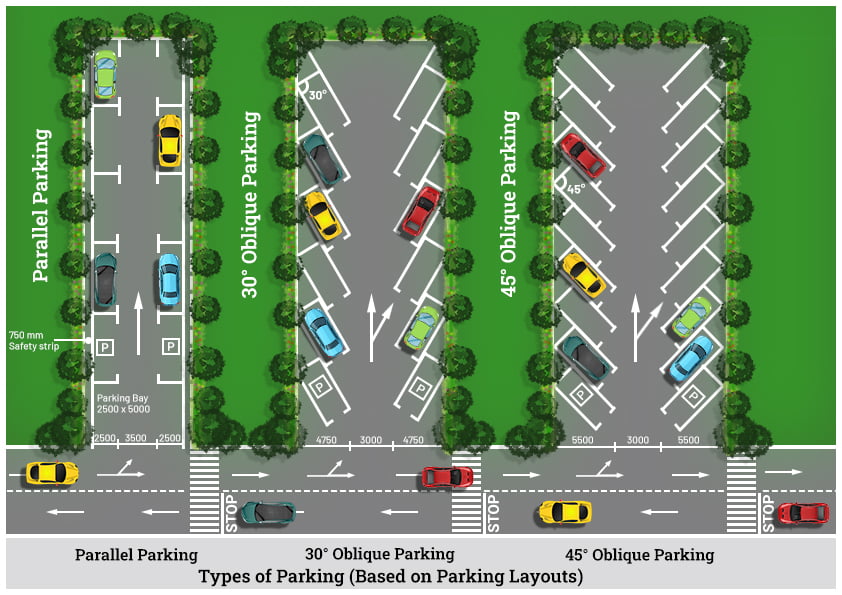
30 Degree parking
This type of parking is known as angular or oblique parking. The layout is arranged at a 30° angle with respect to the ruined alignment. At the center, an access path is designed to park the vehicle in this manner. This type of layout is generally suitable for one-way traffic.
- This type of parking can accommodate more parking than parallel parking.
- It offers more convenience and ease to park the car this way.
- It offers ease in the movement and circulation of vehicles.
- 30° parking offers better maneuverability and reduces delays on the driveway.
45 Degree parking
It is another type of angular parking. The layout is arranged at a 45° angle with respect to the ruined alignment. As 30°, it also has an access path at the center and is suitable for one-way traffic.
- Because of the increase in angle, more cars can be parked in this way.
- The vehicle is easily maneuverable as it does not require a sharp turn while parking.
- As compared to the parallel and 30° designs, it offers more parking space than both of them.
60 Degree parking
Same as the other two, but the layout is arranged at an angle of 60°. It offers more car parking space as compared to others and works like all other angular parking.
- Its advantage is that it takes up less space and enables cars to maneuver in and out with ease.
- Used when there are space constraints but need easy maneuverability.
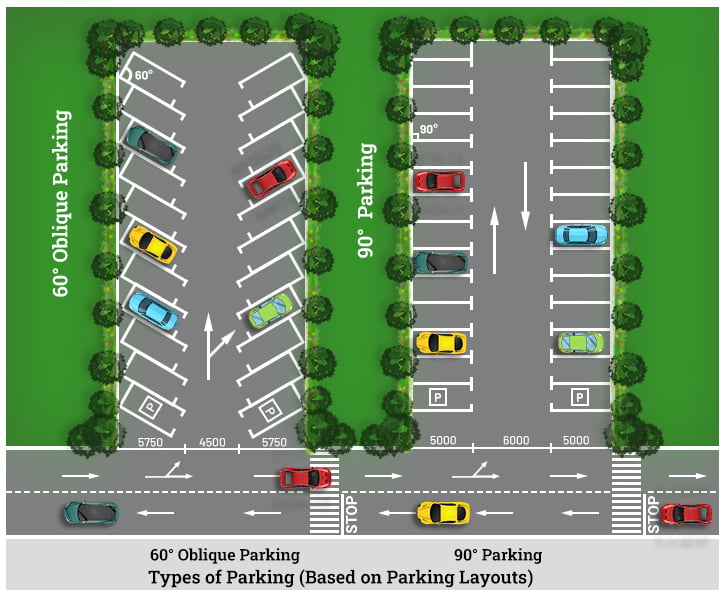
Design considerations
- As per the IRC (Indian Road Congress), the standard dimensions to park a car are taken as 2500 x 5000 mm (17 x 8.5 ft.), and those of a truck are 3750 x 7500 mm (12.5 x 25 ft.).
- Parking lots should not dominate their surroundings. They should be designed carefully. Integrating landscape, signs, pavements, lighting, and various textures to break up the monotony of large areas of gravel or pavement.
- Planting around the parking area will enhance the site and quality of parking standards.
- Well-lit for ease and security in parking and walking.
- Parking areas for various types of cars must be paved and well designated.
- Parking arrangements should be clear and organized, using road markings and signs, preferably with one-way systems. Keep dead ends as short as possible so that the driver can view vacant spaces.
- Parking spaces should be within 20000 mm (660 ft.) of the dwelling.
- A minimum distance of 3600 mm (12 Ft.) around the building is kept free from any parking, loading, or unloading spaces. [5]
- For parallel parking, the spaces should be made 3600 mm (12 Ft.) wide and 7200 mm (24 Ft.) long, and they should either have a 1:6 ramp up to the walk or be separated from it by bollards or some other device if the road level is at the same elevation as the walk. [1]
- According to NBC, one car parking spot for a 4-wheeler vehicle must not be less than 13.75 square meters. In the case of two-wheeled vehicles, it must not be less than 1.25 square meters.
- Parking spaces should be marked or highlighted with 12–20mm-wide (0.5 to 1 inch) yellow or white painted lines.
- When parking is facing a wall, these lines are often painted at a height of up to 1000 mm (40 inches.) for better visibility and understanding.
- Guide rails in the floor along the side have also proved popular for the demarcation of parking items and can be about 500 to 600 mm (20 to 24 inches) long, 200 mm (8 inches) wide, and 100 mm (4 inches) high.
- Where cars are parked face-to-face, transverse barriers about 100 mm (4 inches) high can be used to act as frontal stops. [2]
| Parking arrangement | Space Requirements per car with circulation (per m2) | No. Places in 100 m2 area | No. Places on 100m of road (one side only) |
| For Parallel Parking: Difficult parking and exiting -good for narrow roads | 22.5 | 4.4 | 17 |
| 30° Oblique Parking: Simple parking and exiting. Area busy | 30.8 | 3.2 | 20 |
| 45° Oblique Parking: Good parking and exiting. Area per place relatively low. Normal type of layout | 24 | 4.2 | 29 |
| 60° Oblique Parking: Relatively good parking and exiting. Area per place low. Frequently used layout | 22.5 | 4.4 | 34 |
| 90° Oblique Parking: Low area per place. Considerable turning of vehicle necessary. | 20 | 5 | 40 |
(Source: Neufert)
Off-street parking
Off-street parking facilities refer to designated parking spaces that are mainly designed for parking purposes. These are located away from the main road or streets and have a compound or basement dedicated to parking. It separates the regular flow of traffic and is used as a place to rest a vehicle in an organized manner.
It is either designed on surfaces, underground, on roofs, or elevated. Access to these facilities can be made for either public or private use. They can be managed by the municipality or by private or semi-public enterprises.
Design considerations
As per NBC, these should be followed for off-street parking:
- For a car, the minimum parking space is 3000 mm × 6000 mm (10 x 20 ft.) when individual parking space is required and 2750 mm x 5000 mm (9 to 17 ft.) when common parking space is required.
- Space for scooters, two-wheelers, and bicycles is to be not less than 1.25 sq m and 1.00 sq m, respectively.
- The area of each ECS (equivalent car space), inclusive of the circulation area, is 23 sq m for open parking, 28 sq m for ground-floor covered parking, and 32 sq m for basement parking.
Types of Off-street parking
Off-street parking can take various forms, and here are some of the types:
Surface parking
Usually these are provided at the surface and at some distance from the activity area to be catered to. These are known as ‘surface lots’ or ‘surface parking’. Arrangements are made for the systematic entry and exit of the vehicles. Parking spaces are separated by vehicle type, and a proper circulation area is created to allow for faster movements of cars parking or unparking. These can be designed on private or public land.
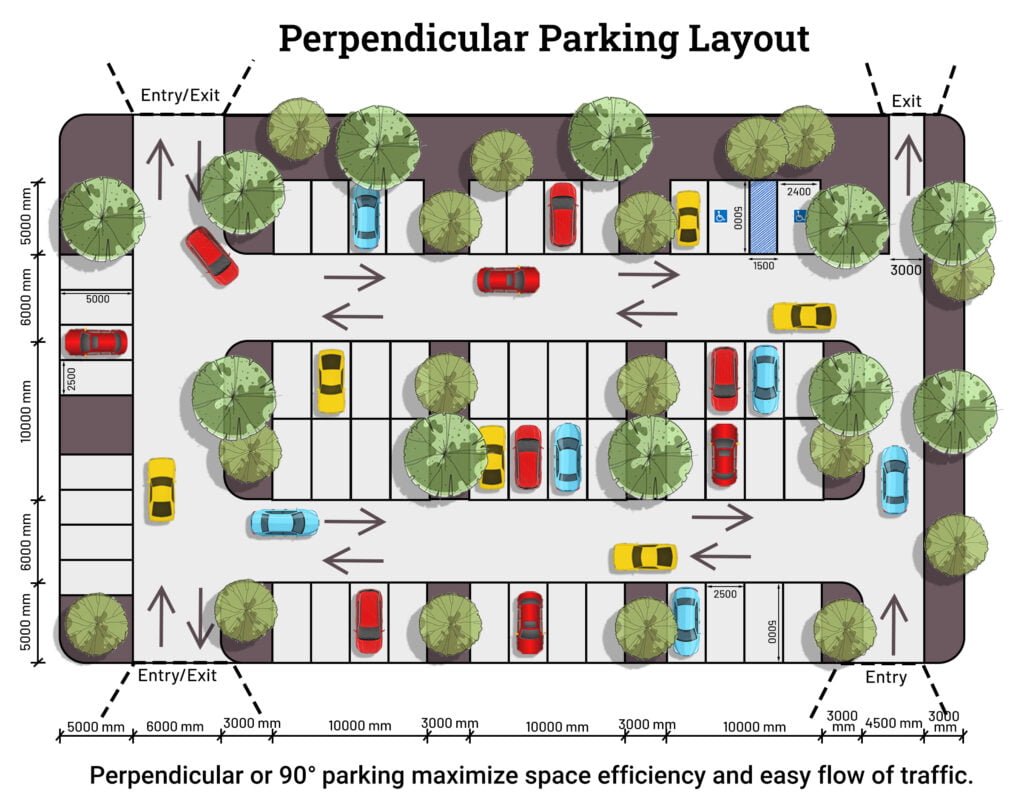
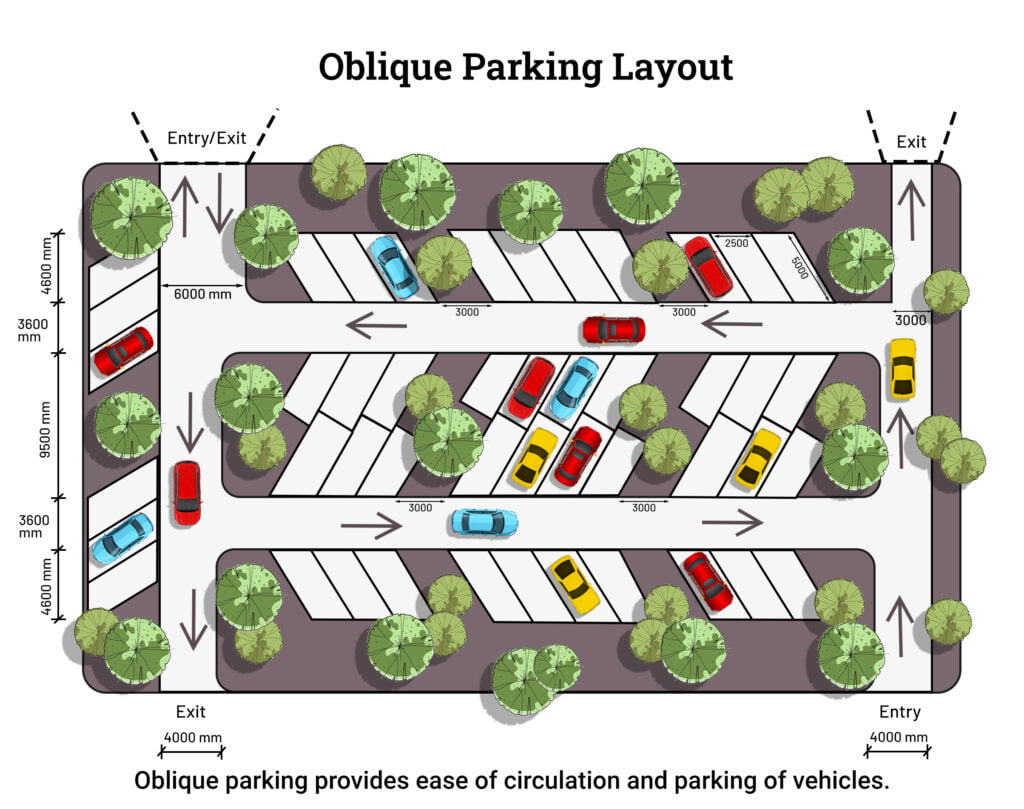
Stilt floor parking
Stilt floor parking refers to a type of parking arrangement where parking spaces are designed on the ground floor, usually elevated above the ground level. The stilt floor may or may not be covered with walls from all sides. The term “stilt” refers to the supporting columns or pillars that lift the parking area above ground level. This design allows for parking standards spaces to be created underneath the elevated structure, maximizing land use efficiency and creating covered parking spaces.
Vertical or Multi-Level Parking
Multi-level parking, also known as vertical parking, refers to a kind of parking facility that can accommodate parking on multiple levels. This type of facility can accommodate a larger number of vehicles at a time, and it maximizes the use of vertical space. Multi-level parking is designed for apartments and commercial establishments like malls, shopping complexes, offices, multiplexes, etc.
This type of parking is suitable for urban areas where the availability of land is limited. It can be designed as an open parking type or an enclosed type.
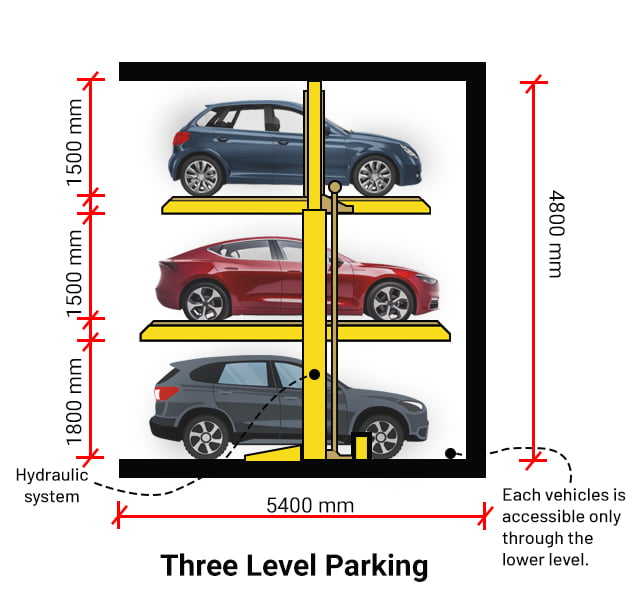

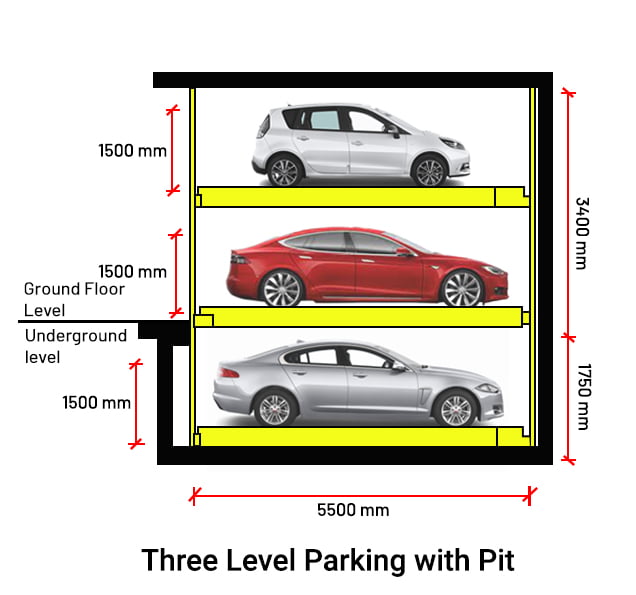
Underground or Basement Parking
Underground or basement parking refers to a type of parking that is constructed below the ground level of any type of building or outdoor space. This type of parking can be provided underneath apartments and commercial buildings to inmates and also to the public visiting the commercial building.
Underground parking involves large quantities of excavation, the construction of retaining walls, ventilation, and lighting. These can also be single-level or multi-level, depending on the need and based on the type of soil and the presence of a water table. Underground parking standards involve a considerable amount of study and investment.
Design Considerations
- The most important considerations that should be taken while designing this kind of parking are the circulation of the vehicles and the entry and exit points.
- For stilt floor parking, a clear height of 2400 mm (8 ft.) should be maintained.
- For basement parking, the floor-to-floor height should be a minimum of 3600 mm (12 ft.).
- Ramp width and radius For one-way straight ramps, the minimum acceptable width is 3750 mm (12.5 Ft.), and for two-way straight ramps, where opposing traffic flows are not separated, 7000 mm (69 Ft.) is the recommended minimum width.
- Circular ramp lanes generally should be 4500 to 5500 mm wide (15 to 18 Ft.). [1]
- The selection of a type of ramp and its location are vital while designing basement parking.
- At the beginning of the ramp, there should be a 3000 mm (10 Ft.) transition space and a drainage channel to avoid crashing cars with the ramp and smooth drainage water flow.
- Basement parking should be planned, leaving a clear space of 6000 mm (20 Ft.) from the site boundary line. Excavation under 6000 mm (20 Ft.) is prohibited.
- Drainage problems in underground parking can be addressed by providing perforated pipes at floor level or covered drain networks and connecting them to sumps of adequate capacity, depending on the area of the parking and the water table, with automatic pumping.
- Provisions of stairs in underground parking shall be made considering safety during fire or any other untoward incidences or emergencies.
- The basement parking should be well lit and ventilated.
- The circulation of vehicles should not be planned adjacent to the columns.
- Avoid using rectangular or square columns inside the basement for safety reasons; consider designing circular columns for aesthetics and safety.
- Add yellow or red strips on the edges of the column to highlight it with the reflection of light. This makes columns visible from far ends and provides more safety to the users. It also enhances parking standards.
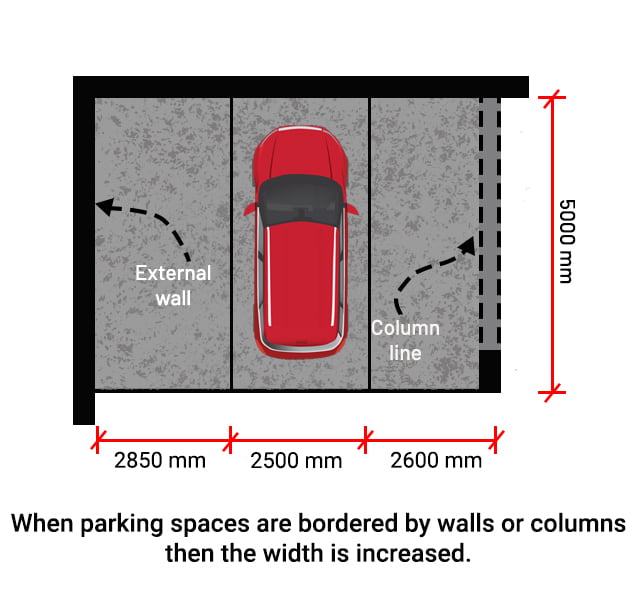
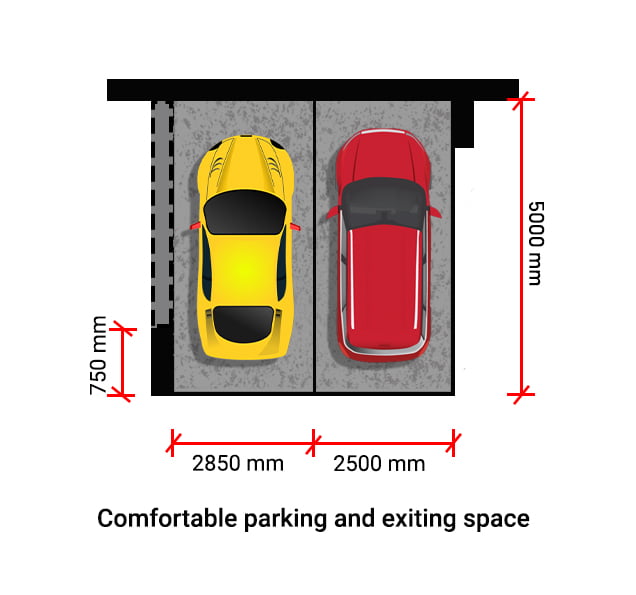
Local guidelines, parking standards, and norms
- Underground parking requires proper illumination during all hours. Minimum illumination of 50–75 lux shall be provided through proper lighting systems.
- Gradient of the ramp: 1:10 slope generally and 1:8 slope for very short ramps
- Clear height between floors: 2400 mm (8 Ft.), and parking bay dimensions should be 2500 mm x 5000 mm (8.2 ft. x 16.4 ft.)
- Inside radius of curves: 7000 mm (23 Ft.)
- Width of traffic lane on ramps and entrance: 3750 mm (12.5 Ft.)
- Gradient of sloping floors: not steeper than 1:20 slope.
- There will be no restriction on the number of levels in the basement, subject to structural safety. [4]
- A basement used for parking, one toilet, two urinals, and two washbasins for every 500 cars or part thereof shall be provided on each floor.
- The shear walls shall be constructed on all three sides of the parking floor so that it is not a soft floor.
- All stilt parking is required to be provided with a sprinkler system where such buildings are required to be sprinkle red.
- All sprinklers in car parking shall be standard response type with a minimum K-factor of 80, area coverage of 9 sq m, and design as per good practice.
- All fire exit doors from the car parking to the exits shall be painted green and shall display exit signage.
- Fire escape staircases, at least 1250 mm (50 inches) wide, shall be provided at appropriate locations so that no place is more than 45000 mm (150 Ft.) from the nearest staircase. Horizontal walkways, at least 1000 mm (40 inches) wide for access to all the areas, shall be provided at every parking level.
- Hydrants shall be provided at each entry to the station on the ground and upper levels near the staircase. At least one hydrant for the parking area shall be provided, subject to a travel distance of 30000 mm (100 Ft.) to the nearest hydrant. [3]
| Vehicle | Space Required (in Sq m) |
| Car | 20-36 sq. m |
| Buses | 55-60 sq. m |
| Trucks | 55-60 sq. m |
| Three Wheelers | 10-15 sq. m |
Source: Indian Road Congress
Parking Bay Dimensions
Parking spaces are usually outlined by 12 – 20 mm (0.5 – 1 inch) wide yellow or white painted lines. The standard dimensions of a car parking bay are 2500 x 5000 mm (8.2 x 16.8 ft.). Below are the are the standard dimensions of parking bays for different types of vehicles:
- Bicycle parking bay Standard Dimensions in mm:- 700 x 1800 mm (1.4 x 6 Ft.)
- Two-Wheeler Parking Bay Standard Dimensions in mm:- 1000 x 2300 mm (3.4 x 7.8 Ft.)
- Car Parking Bay Standard Dimensions in mm:– 2500 x 5000 mm (8.4 x 16.8 Ft.)
- Transport vehicle /Ambulance / Mini Bus Parking Bay Standard Dimensions in mm:- 3750 x 7500 (12.5 x 25 Ft.)
- Bus Parking Bay Standard Dimensions in mm:- 14000 x 3000 mm (46.8 x 10 Ft.)
Source: Indian Road Congress
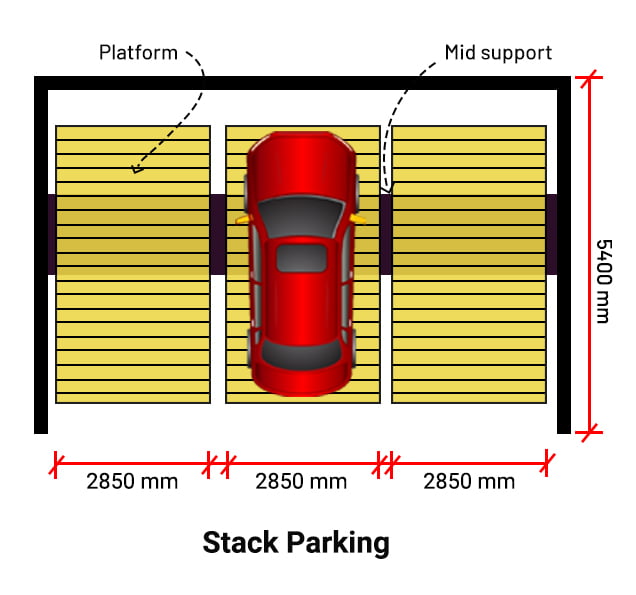

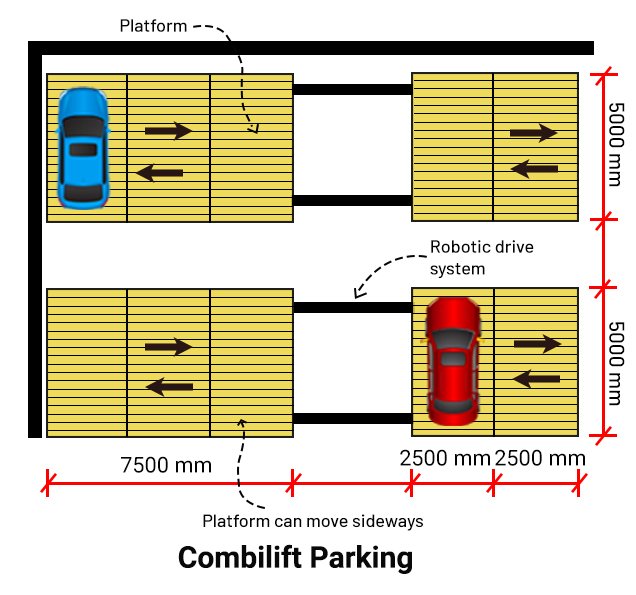
There are several other types of parking, like roof parking, rotary parking, robotic parking, stacker parking, Combilift parking, puzzle parking, tower parking, etc. These other types of parking and standards will be discussed in the coming days; some of these types are shown in the figures above.
Garage or Private Parking
This type of parking is referred as the private parking within a designated structure or building enclosed with walls commonly known as garage. A garage can be designed attached to the house, part of commercial buildings, or a standalone structure. They are meant to provide shelter, protection, and security to the parked vehicles inside it. A garage can be designed with additional storage space or with other amenities.
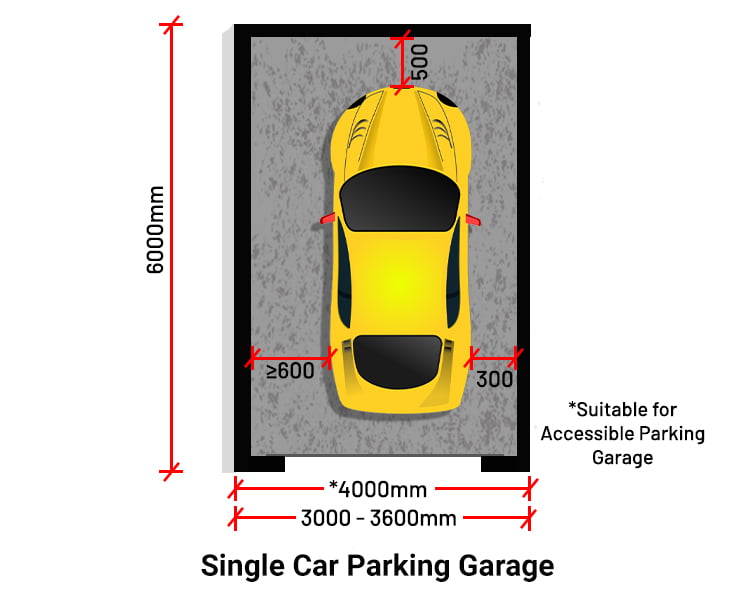
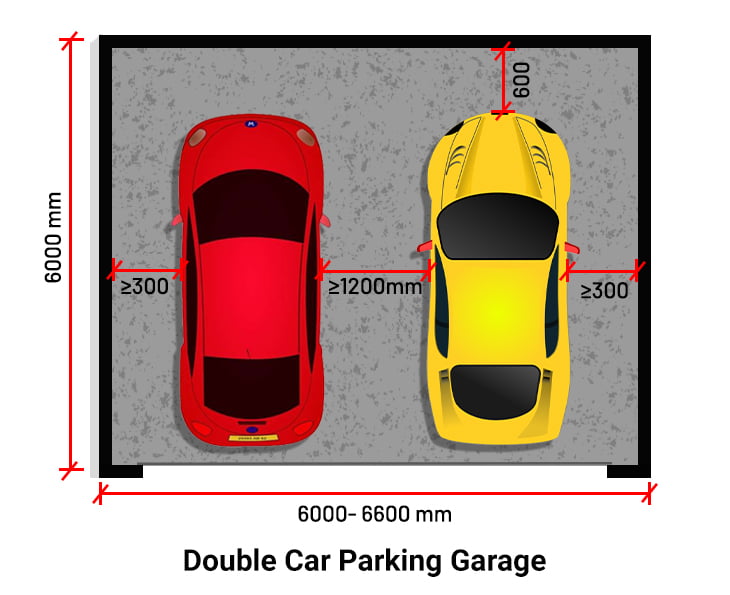
Design Considerations
- A private garage for one car should be designed with a dimension of 3000 mm x 6000 mm (10 x 20 Ft.).
- A private garage for two cars should be designed with dimensions of 6000 mm x 6000 mm (20 x 20 Ft.).
- The garage should be designed near the main gate, not far away from it.
- The garage should be designed in such a way that it requires a limited amount of circulation to reach it.
- A garage can be designed for up to 2 cars and a bike parking; planning above it can lead to several issues.
- A garage should have an automatic or manual door to enclose it; a semi-open garage cannot ensure full safety.
- Attaching a garage to the building provides feasibility and several other benefits to the user.
- Constructing a structure over a private garage is not recommended.
Accessible Parking
Accessible parking also known as handicapped parking is a specific designated parking space for individuals with disabilities. This type of parking is designed to provide easier access and comfortable parking standards space for the peoples with disabilities. Ensuring a closer parking space near to the building facility.
Location of the Parking
- The designated accessible parking spaces that service a building must be as close to the main entrance as possible, and the distance between the accessible parking place and the main door must not exceed 30 m.
- In the event that access is by lift, parking shall be located within 30000 mm (100 Ft.) of the lift lobby.
- Where indoor parking is provided, a suitable passenger lift or separated pedestrian ramp shall be installed to provide access from the parked vehicle to the principal entrance of the building or buildings served by the car parking.
Number of Designated Accessible Parking Spaces
The following number of designated space should be provided in every parking areas:
- One designated accessible parking space should be designed in every parking area.
- For a parking space of up to 50, three designated accessible parking spaces should be designed.
- For a parking space of up to 200, six designated accessible parking spaces should be designed.
- Accessible parking spots shall be provided in a ratio of 1:50 for parking facilities with a maximum capacity of 400 spaces.
- For parking facilities with more than 400 spaces, at least 8 accessible parking spaces should be provided, plus 1 space for each additional increment of 100 cars over 400.
Signage for Parking
- An international symbol of accessibility shall be displayed at approaches and entrances to car parking to indicate the provision of accessible parking lots for persons with disabilities within the building premises.
- Internationally accepted directional signs should be placed at the routes leading towards the parking space.
- Accessible parking should be highlighted with the blue marking, and the signage should be located there.
- A vertical reserved board should always be placed there at a height of 2100 mm (7 Ft.) to make it easily visible from a distance. And also an imposing fine sticker for reserved parking.
Car Park Entrance and Parking Controls
- The car entrance should have a clear height of 2600 mm (9 Ft.) from ground level.
- If a payment machine is provided, it shall provide all control at a height between 800 mm and 1000 mm (32 and 40 inches).
- The machine should be located in a place where it doesn’t create any barriers or hazards for people with disabilities and is easy to use.
Accessible Car Parking Space Dimensions and Surface Requirements
The accessible car parking standards space should have the following requirements:
- The desirable width of the accessible parking bays should be 3900 x 5400 mm (13 x 18 Ft.).
- The minimum width of an car parking space is 3900 mm (13 Ft.), while the minimum length is 5400 mm (18 Ft.). This minimum width includes the transfer area beside the car, which must be at least 1500 mm (5 Ft.) wide.
- Widely used, two accessible parking spaces with one shared transfer area must be at least 6300 mm (21 Ft.) wide.
- It shall have a firm, level surface without aeration slabs.
- If it is possible, then it should be sheltered.
- Both the side and rear transfer zones should have yellow or white cross-hatch road markings.
- The designated accessible parking spaces must have a gradient of no more than 1:50 slope along their length and width.
- Wheelchair users must have an accessible route of 1200 mm (48 inches) width to pass behind vehicles that are backing out.
- Parking space along the footpath or sidewalk for roadside parking of an accessible van; the minimum dimensions shall be 9000 mm × 2400 mm (30 x 8 Ft.) with a kerb to access the nearest footpath or sidewalk.
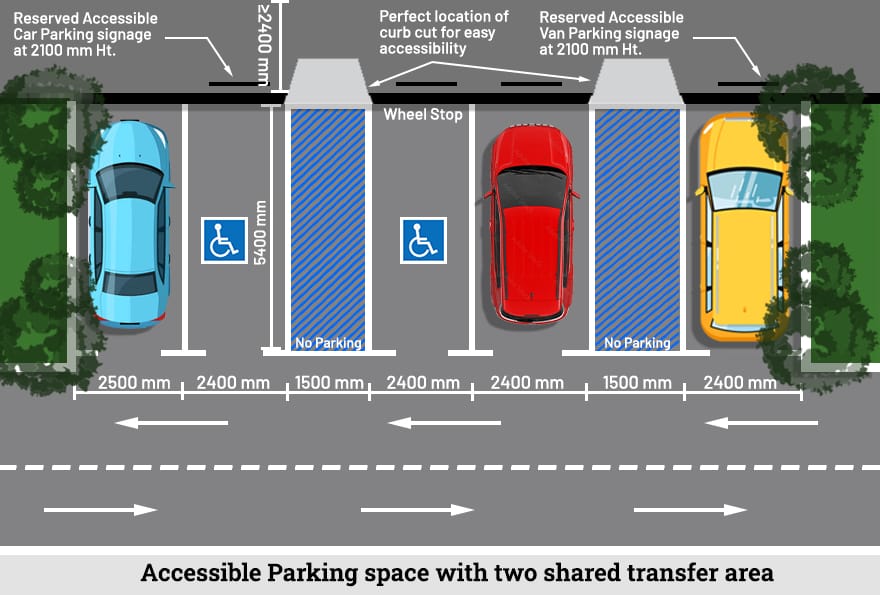
Design Considerations
- An accessible parking garage for one car should be designed with a dimension of 4000 mm x 7200 mm (13.5 x 24 Ft.).
- Accessible parking should be planned at the front of the parking area.
- The access aisle’s perimeter must be designated. The end can be either square or curled.
- Proper consideration should be given to the signage and markings to make the space more comfortable.
- In the case of indoor parking, a clear height of 2400 mm (8 Ft.) should be provided.
- For angled parking spaces, the extra space at the end of a row can be used as a parking aisle for disabled people.
- If a curb exists, curb ramps should be provided to link accessible parking spaces to accessible pathways.
- If no curb exists, a textured surface at least 600 mm (24 inches) wide must separate the pathway from the vehicular area, or else bollards should be used.
- Pre-cast wheel stops can be used to create a passage that is at least 900 mm (36 inches) wide.
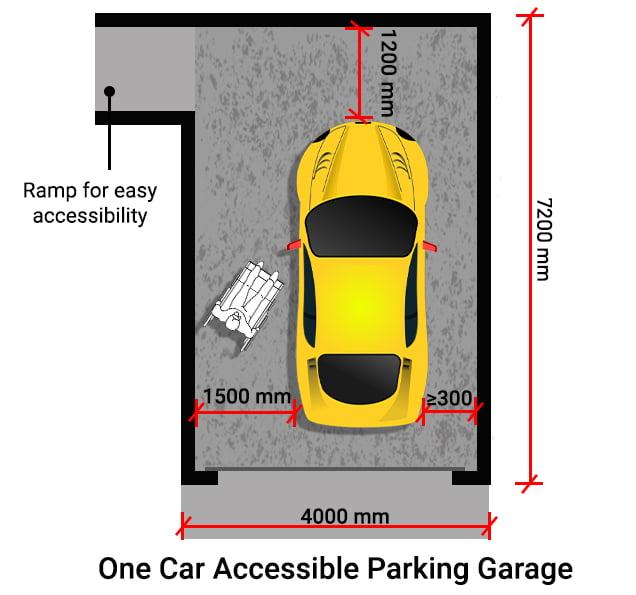
What is ECS and How it is calculated?
ECS in parking stands for Equivalent Car Space. It is a unitary space required by the different vehicles to park. 1 ECS is equal to 12.5 sq m, which is 2500 x 5000 mm (8.5 x 17 ft.) (the space required for a car parking bay).
How to calculate the number of cars required to park for a total built-up area as per the parking standards.
We have given an ECS per 100 sq m of area. Now we have to find out the required number of car parking spaces.
Simply calculate the total built-up area and multiply it by 1 per 100 sq m. You will get the total number of cars you have to park.
The formula stands as: No. of Cars = Total Built-Up x 1 ECS/100
For different vehicles, ECS values change, as shown in the table below.
| Vehicle Type | ECS |
| Car/Taxi | 1.00 |
| Two Wheelers | 0.25 |
| Auto Rickshaw | 0.50 |
| Bicycle | 0.10 |
| Two Wheelers | 0.25 |
| Trucks/Buses | 2.50 |
| Emergency Vehicle | 2.50 |
| Rickshaw | 0.8 |
Source: URDPFI Guidelines, MoUD 2014
Local guidelines, parking standards, and norms
As per NBC, for the provision of general car parking spaces, the space standards shall be as follows:
- For open or surface parking, 18.0 sq m. per ECS (equivalent car space).
- For ground-floor covered or stilt parking, 23.0 sq m. per equivalent car space.
- For basement or underground, 28.0 sq m per equivalent car space.
The area given here comes with the circulation space. (The values mentioned above can change from state to state, and as per different guidelines or parking standards, the information shared here is for the capital region only.)
The Ministry of Housing and Urban Affairs model building bye-laws of 2016 allow 2 ECS per 100 sq m of floor area in residential premises. That means you get 1 space per 3 BHK and 2 spaces per 4 BHK.
| S. No. | Use/Use Premises | Equivalent Car Spaces (ECS) Per 100 sq. m of floor area |
| 1. | Residential Group Housing, Plotted Housing(Plots above 250 sq. m.) and Mixed Use. | 0.50 -1.50 |
| 2. | Commercial i) Wholesale Trade and Freight Complex (including parking for loading and unloading) ii) City center, district center , hotel , cinema and other iii) Community center , local shopping center, convenience shopping center. | 1.50-2.50 1.00-2.00 0.50-1.50 |
| 3. | Public and Semi-Public Facilities i) Nursing home, Hospitals , (other than government), social , cultural and other institutions, government and semi-government offices. ii) Schools, college, university and government hospitals. | 0.50-1.50 0.25-0.75 |
| 4. | Industrial Light and service industry, flatted group industry, extensive industry | 0.50-1.00 |
Source: Modern Building Bye Laws, Chapter-3
Turning Radius in Parking
The turning radius in parking refers to the minimum space required for a vehicle to make a turn at a certain angle or shape while navigating through a parking area. It is a crucial factor in determining the maneuverability of a vehicle, especially when entering or exiting parking standards spaces. It is difficult to make generally valid recommendations for the selection of the correct turning place.
Vehicles with smaller turning radii are generally more maneuverable, making them well-suited for navigating parking lots and structures and executing parking maneuvers such as parallel parking.
The turning of a vehicle generally takes place in a 90-degree, circular, semi-circular, U-turn, etc. The road or path width should be adjusted so that the turn can happen without any disturbance or accident issues. Below, a turning radius and other parking standards, with appropriate dimensions is discussed through images:
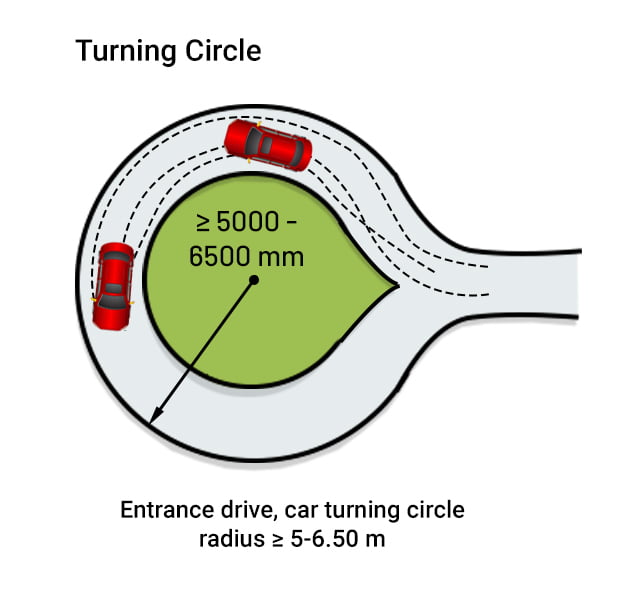
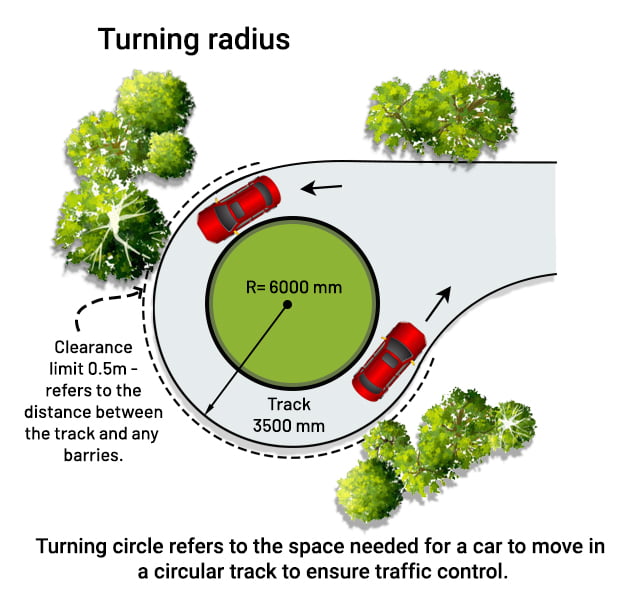
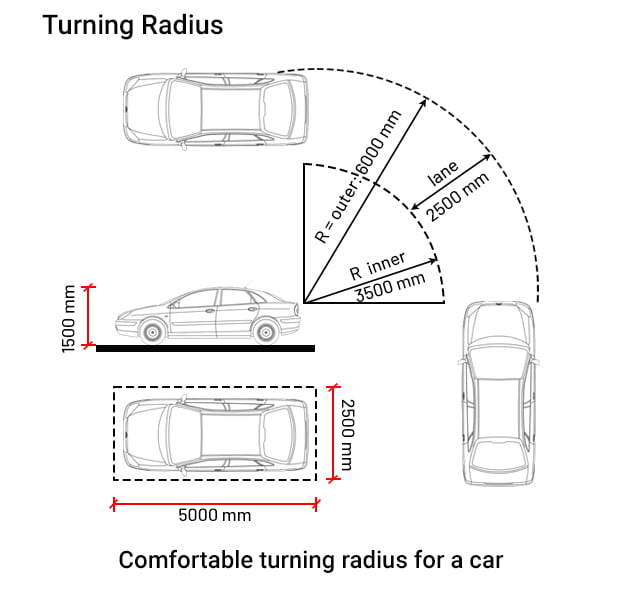
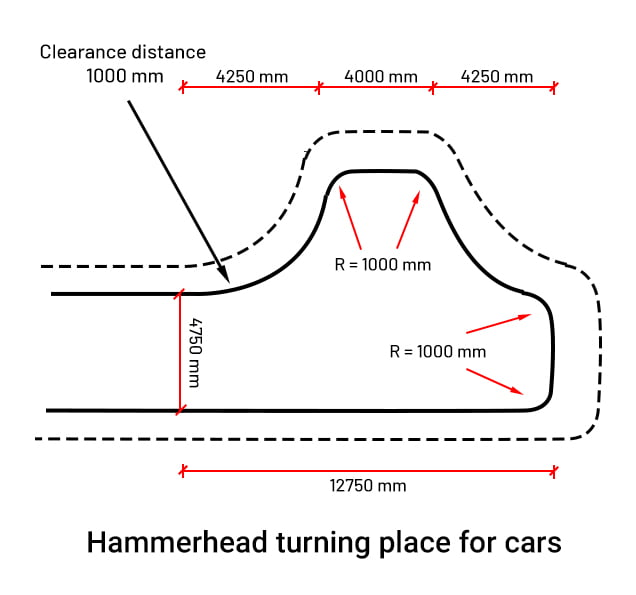
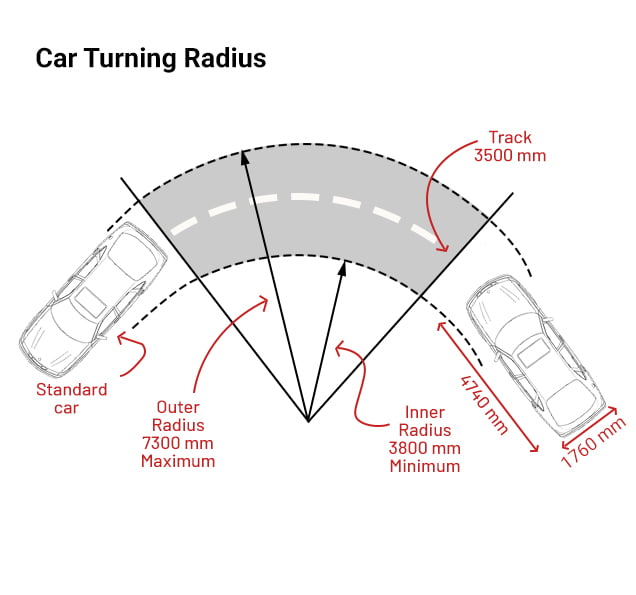
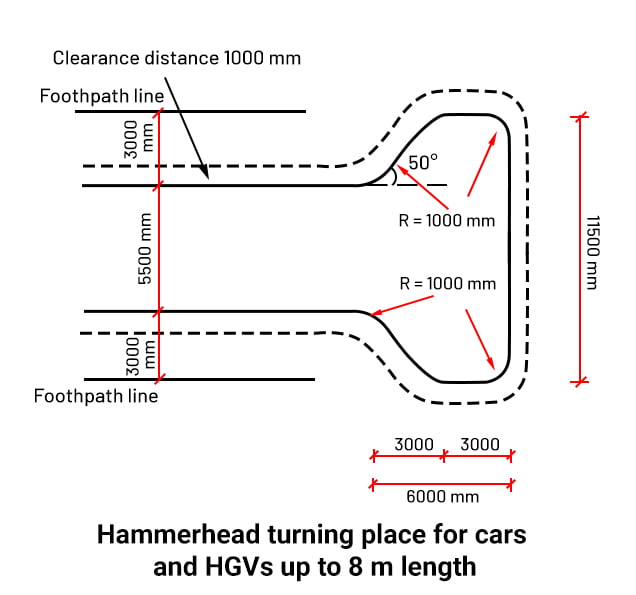
Design considerations
- Road turning can be designed as hammer heads, turning circles, or loops.
- The hammerhead-type turning place calls for backwards and towards maneuvering.
- Hammerhead turning places are really only suitable for cars.
- Turning circles and loops are preferable, as motor vehicles can drive straight around them without having to stop.
- Adequate clear space should be given along the outside edges of the turning areas to safeguard fixed obstructions from the overhang of tuning vehicles.
- The curbs on the edges of the road should not be sharp; it can lead to accidents.
- At the turning, there should not be heavily planted space, as it can cut the visibility of the driver or rider.
*Note: The dimensions written in inches and mm are individual dimensions, not converted












13 Responses
Hi Raju,
Can you please give the reference of NBC rule or act on the parking space?
Regards
Sutirtha Gupta
Hey there!
I have already mentioned all the information sources in the article.
If you still have any queries or want to read more about it.
Check out these information:
NBC Volume 1 (Part 3): Off Street Parking (Page 42 to 60)
: Accessible Parking (Page 75 to 78)
(Part 4): Car Parking Facilities (Page 94 to 96
A minimum distance of 3600 mm (12 Ft.) around the building is kept free from any parking, loading, or unloading spaces.
Please provide reference for the above.
“Thank you for your comment. I appreciate your feedback and apologize for any confusion caused by the reference thing. Actually, the information is taken from UDCPR-2020. I have added the reference for the same. If you have any further questions or concerns, please feel free to let me know.”
Please provide the exact source of the following things you have added in your article
1.local guidelines, parking standards and norms
2.Signage for parking
3.car park entrance and parking controls
4.turning radius in parking
Thank you for your inquiry. The information mentioned in the article is based on several reputable sources, including Neufert Architects’ Data, Timesaver Standards, Metric Handbook, Indian Road Congress, URDPFI Guidelines, MoUD 2014, Modern Building Bye Laws, Chapter-3, and NBC 2016 (Part 1 & 2), as well as UDCPR-2020.
While I can’t provide exact page references without reviewing each source again, I can assure you that the content was carefully verified by both myself and experienced professionals. If you’d like to cross-check the data, I recommend reviewing these sources, as they will provide a comprehensive understanding of the standards discussed.
Thank you for your understanding.
Please provide the reference series vise as i have questioned in 1,2,3 format please
Ok, I can go a bit close, Here are the sources for the information you asked:
1. Local Guidelines, Parking Standards, and Norms:
• Indian Road Congress (IRC)
• Urban and Regional Development Plans Formulation and Implementation (URDPFI) Guidelines
• MoUD 2014 (Ministry of Urban Development)
• Modern Building Bye Laws, Chapter-3
2. Signage for Parking:
• National Building Code (NBC) 2016 – Part 1 & 2
• URDPFI Guidelines
• Indian Road Congress
3. Car Park Entrance and Parking Controls:
• Neufert Architects’ Data
• Timesaver Standards
• NBC 2016 – Part 1 & 2
• Indian Road Congress
4. Turning Radius in Parking:
• Metric Handbook
• Neufert
• Indian Road Congress (IRC)
• UDCPR-2020 (Unified Development Control and Promotion Regulations)
While I can’t pinpoint the exact pages without a detailed review, I assure you that the information was thoroughly verified by myself and other professionals.
Hi Raju,
Thank you for the insights. I would like to ask if there are
1. Parking guidelines for Refuse collection vehicles,
2. Online food delivery drivers who mostly use two-wheelers,
3. NBC states 1 parking space for every 50 sqm of built-up area (Car parking spaces which also include motorcycles as per section 10.4, NBC, page 42), then how it is divided into car and two-wheeler spaces further?
Your reply is very much appreciated
Thanks
Hi Tanvi,
Thank you for your question. Here are the responses:
1. I will incorporate a dedicated section in the article containing this specific information within the next few days.
2. Currently, there are no provisions for a dedicated parking area for food delivery vehicles, and it’s unlikely that such requirements will be implemented in the future. Delivery vehicles can utilize regular bike or car parking spaces as they typically don’t require long-term parking.
3. According to the NBC, 20% of the total parking area is allocated for bike parking, while 80% is designated for car parking.
If you have any further questions or require additional information, please feel free to reach out.
Dear Raju,
First, I do like the information and detail of this article and the layout of it. It is clear and informative – thank you.
I hope you can assist me with the following enquiry regarding car park design.
Many, many years ago I had to take a case to court on behalf of a friend in respect of an accident in a car park. This was a one-off for me and I’ve not had to deal with anything like it since. Whilst researching the design of car parks for this case I tried to establish the guidelines for ‘best practice for car park design in respect for the egress of a car park onto the public carriageway.
I recall that the exit route to join the public road should be designed, where possible, to merge with the traffic and not approach the carriageway at 90 degrees unless there was some form of traffic management / control (e.g. automatic traffic signals (traffic lights)).
This design layout / feature was done so as minimise conflict with traffic on the adjacent and joining public carriageway and negate side impact collisions (‘T bone’ crashes) and, in the unfortunate event of an accident/collision, it would be ‘side-on-side’ and so considerably reduce the likelihood of serious injury to a vehicle’s occupants.
As stated above, the case I presented was a long time ago (at least 25 years) and I haven’t kept notes from it so wondered if you had a point of reference / details as to what is best practice for the layout route for exiting a car park so I can look to for further research on this matter – and to see if there’s any update for me to consider.
Thank you in advance for your assistance on the matter.
Brennan
Thank you for your question and your positive feedback on the article. As of now, I have limited information about the British Standards for Car Park Design, as I am more aware of the Indian standards, but you can follow these steps or instructions to get valid information to help in your research on this topic.
• You should read British standards from books like the Design Manual for Roads and Bridges, Parking Standards by Thurrock Council, Guidelines of the British Parking Association, and others.
• Read local British county guidelines.
• Visit the Institute of Transportation Engineers.
• Talk to a professional organization or expert in this particular field.
By consulting these resources, you should be able to find current best practices and ensure that your understanding is up-to-date. I hope this information helps with your research.
Hey people!!!!!
Good mood and good luck to everyone!!!!!